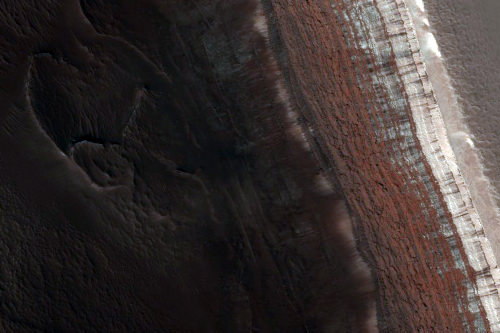[/caption]
In 2008, the HiRISE camera on the Mars Reconnaissance Orbiter was monitoring a certain region on Mars for changes in frost patterns as spring progressed, and serendipitously captured an
avalanche
in action. This year, the HiRISE team has been on the lookout, ready to capture more
avalanches
as spring approaches in Mars' northern hemisphere. They've been successful -- and how! This awesome shot was captured on January 27, 2010 of a steep cliff in the northern polar region of Mars, and shows at least three isolated clouds of particles falling from the cliff. The HiRISE teams says that these clouds, rolling or hovering close to the ground likely reach up tens of meters high (up to 180 feet)! The avalanches are a result of carbon-dioxide frost that clings to the scarp in the darkness of winter, and when sunlight hits them in the spring they loosen up and fall. The cliff, approximately 700 meters (2000 feet) high is made up of layers of water ice with varying dust content, roughly similar to the polar ice caps on Earth. But wait, there's more! Yes, it's avalanche season on Mars!
[caption id="" align="alignnone" width="580" caption="Another avalanche seen earlier in 2010. Credit: NASA/JPL/University of Arizona"][/caption]
Here's another avalanche captured on January 12, 2010, and below, the HiRISE camera was trained on the same site that the original avalanche was captured back in 2008.
[caption id="attachment_62201" align="aligncenter" width="560" caption="A shot monitoring the original site of active frost-dust avalanches (ESP_016173_2640) Credit: NASA/JPL/University of Arizona"]
[/caption]
The HiRISE teams says that by looking at all of the individual instances of avalanches from all of the images will also allow them to piece together a sequence of snaphots of the whole avalanche process, from beginning (a stream of material falling down the cliff face) to end (lingering puffy clouds). Patrick Russell writes:
Based on this year's observations, these events happen mostly in the middle of spring, roughly equivalent to April to early May on Earth. And, they are indeed more widespread than just this one scarp. All together, it seems this is a regular spring process at Mars' north pole that may be expected every year - avalanche season! This information, in conjunction with the results of numerical modeling of the behavior of the materials involved, will help us find out what is causing these dramatic events.
For more wonderful images, check out the
HiRISE website.
 Universe Today
Universe Today
